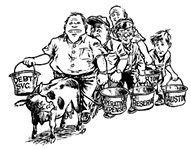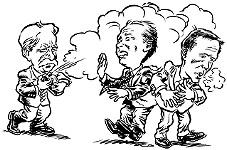Model Policing
Chief Watson Stands Up for Community Methods
By Alex de Marban, Fri., Sept. 6, 1996
Currently, they're scattered at 11 neighborhood centers across the city, but they're on Police Chief Elizabeth Watson's endangered species list. That comes as a surprise, since community policing -- police/community interaction -- has been Watson's mantra since she came to the city four years ago. She's stuck with the concept, despite its political combustibility. It's currently getting the blame for the city's sharp increase in violent crime, since it translates into less officers cruising the streets. Watson and her methods were heavily questioned at last week's council work session, and the Austin Police Association and Watson regularly dance on the edge of altercation. Still, she perseveres. At the work session she announced even bolder plans to accomplish her community-policing goal.
Ironically, part of that means cutting the neighborhood centers. And if the council approves Watson's proposal for the coming fiscal year, it would also mean eliminating the department's remaining community outreach programs, such as DARE and the Police Activities League.
So why does Watson want to cut the heart of her community-policing agenda? Basically, she doesn't have a choice. She's suffering from a lack of patrol officers because of unanticipated retirements, and now is not the time to be understaffed. While most of Texas is basking in the glow of a slowed crime rate, especially in the area of violent crime, the local daily's front pages are reading more and more like murder mysteries. The Statesman reported that from 1994 to 1995 in Austin, homicides increased 24%, from 37 to 46. Rapes increased by the same amount and aggravated assaults rose 66%. Statewide, on the other hand, murder fell by 16%. Rape by 6%. And robbery by 11%.
So Watson intends to re-deploy Officer Davis and his cohorts from the sidewalks to the roadways. While community police officers provide direct interaction between the public and officers who know the neighborhood, patrol officers, with their marked cars and wide-ranging mobility, are considered to be the key device for law enforcement. Watson's plan would add 36 officers to the patrol force, putting it at full capacity. She also intends to create a third cadet training class beginning next year, allowing an additional 41 officers a year. This would also allow the 36 community officers to return to their outreach programs in 1998, while still adding to the patrol unit.
However, to make sure that her community policing cause remains king, Watson unveiled the most contentious plan of all at the work session -- the "one-third model." Expected to become the department's new goal in life, the model calls for an officer's time to be divided three ways between community outreach, enforcement, and paperwork. Currently, Assistant City Manager Joe Lessard estimates that the police spend 47% of their time making arrests, and only 35% of their time in prevention. Watson and Lessard figure that additional patrol officers will allow police more time to focus on crime prevention, like visiting families or hanging out at neighborhood parades.
The new one-third model represents a sharp break from the past. APD has traditionally measured itself with a per-capita model. Currently, for instance, the department has about 970 officers, or 1.8 per every 1,000 Austinites. But Watson and Lessard now say the per capita model does not provide apt performance measurement.
"We're suggesting you need to look at how you utilize an officer's time, and that doesn't take into account the numbers per thousand," says Lessard. "With the one-third model we can be more precise with how we use limited resources."
But to get to that one-third model, Watson and Lessard must still rely on a per-capita foundation. Watson predicts the model can be reached once the police force hits 2.2 officers per 1,000 Austinites, and once technological infrastructure, like improved networking, is achieved.
The idea immediately drew heavy questioning and doubt at the work session. Todd called the model interesting, but added that it falls short of being useful. (Todd wants to achieve 2.5 officers per 1,000 residents). He couldn't understand -- and got no reasonable explanation -- why 2.2 officers per 1,000 residents was the magic number to achieve Watson's model, implying that more officers would be needed.
Todd's speculations didn't please Watson any, and with an uncontained aggression, she put the ball back in his court: "I'm the chief of police, Mayor. I never have enough officers. Give me more officers."
But the real bomb fell when Lessard stated that the police department was moving away from the per-thousand figure because "There's no direct correlation between number of officers and actual crime rate."
Longtime members of the police association, like Mike Sheffield, vice-president of the association, swear otherwise. As proof, Sheffield points to Watson's tenure as the Houston police chief, and the dramatic decrease in violent crime that came with her departure. Houston increased its police force to three officers per 1,000 residents, and murders there dropped from 375 in 1994 to 316 in 1995.
Police Association members decry the council's inability to commit the necessary resources. In fact, the lack of such will allow the city to add only eight officers between 1997 and 1998, putting the force at only 1.9 officers per 1,000 residents, woefully understaffed for a city of Austin's size, says Sheffield.
But that doesn't seem to bother everyone. Councilmembers Beverly Griffith and Gus Garcia are more concerned with the social aspects of policing. Neither agrees with the old per-capita way of looking at police, and they're combing the budget for $1.4 million to invest in youth activities at the park system, which could help deter juvenile crime (see Budget Priorities, p.28). Mayor Todd, Ronney Reynolds, and the police association would no doubt prefer that money be spent on improving and increasing the force. Griffith, Garcia, and the rest of the council might be amenable to that, though it would take some soul-searching to sacrifice social programs in favor of adding more police officers.
"This is about our police department and where it's headed into the next century," says Sheffield. "Are we going to be able to meet the demands of growth? If the city council makes us a priority, we will."
This week in council: The public hearing on the bike helmet law continues at 7pm, Thursday, Sept.5.
Got something to say on the subject? Send a letter to the editor.








